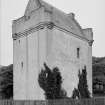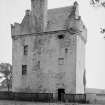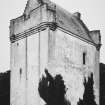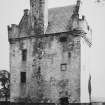Following the launch of trove.scot in February 2025 we are now planning the retiral of some of our webservices. Canmore will be switched off on 24th June 2025. Information about the closure can be found on the HES website: Retiral of HES web services | Historic Environment Scotland
Field Visit
Date 5 July 1911
Event ID 1117184
Category Recording
Type Field Visit
Permalink http://canmore.org.uk/event/1117184
Craigcaffie Tower.
This tower (RCAHMS 1912, figs. 20 and 21) is a small 16th-century keep situated 3 m. to the NE. of Stranraer, on the, Cairn Ryan road. The site is low-lying, and to the N. of the tower there are traces of what may have been a fore-court, containing a well. In a view published in 1889* some fragments of outbuildings are shown to the E. of the keep, but these have now disappeared. A fosse can be traced for a few yards to the W. of the tower. Externally the keep is simple in appearance, the gable walls being finished with parapets and terminating in angle bartizans. There is no evidence to show that the parapet continued round the building. The entrance doorway in the N. wall has a bold quirked bead on the angles of the jambs, and has evidently been surmounted by a pediment, of which little can now be traced. Over the doorway, and at some height from the ground, is a panel within a moulded architrave, divided into two parts; the upper containing an inscription now illegible; the lower two escutcheons. The dexter shield surmounted by the initials I N, for John Neilson, displays the Neilson arms: parted per chevron; in chief, two sinister hands couped and erect; and, in base, a dagger, point downwards: a star at fess point for difference. The sinister shield is surmounted by the initials M S, for Margaret Strang, his spouse. It is much weathered, but appears to have been charged with a chevron between three lozenges. The doorway is defended by a machicolation at the wall-head level carried upon two corbels. The windows have moulded jambs, and the architrave of the NE. window on the second floor has a late dog-tooth enrichment. The skew-puts to the N. are inscribed: one bears on a shield the date 157- ; the other repeats the initials I N M S; the skew-puts to the S. bear heraldic roses. The gargoyles are octagonal and fret-panelled lengthwise. The entrance to the tower opens immediately on to the wheel-staircase, which is fairly wide and of easy ascent. At the stair foot is the entrance to the kitchen, a vaulted apartment 13' 6" X 16' 6", lighted by four small windows, and containing a well 2' in diameter, now filled up. In the E. wall is an opening which was possibly an open fireplace. To the S. of the staircase is a small domically vaulted chamber with a trap in the dome. The entrance to this chamber is almost in line with the well. The trap would probably be used for the haulage of water and other supplies from the kitchen to the principal floor. The first or principal floor consists of one apartment measuring16' X 14', lighted by two windows, and having a fireplace in the N. wall. To the S. of the stair is a small chamber, probably a buttery, in the floor of which is the trap mentioned above (now floored over). The upper floor is a replica of the one below. The garret now extends the whole length of the tower, but was formerly subdivided by a wooden screen from N. to S. There is a fireplace in each gable. Access to the parapet walk was obtained by doors in the gable walls some 4' high from the garret-floor level. The building is well roofed, and has been put in a satisfactory state of repair by the proprietor, the Earl of Stair.
The lands of Craigcaffie were for centuries possessed by the family of Neilson. The earliest notice of the property is in the beginning of the 14th century, when Robert the Bruce made a gran t of the lands of "Kellechaffe" to John, son of Neil of Carrick (1), from whom the Neilsons claimed their descent. The Neilsons remained in possession down to the second half of the18th century. Since 1791 the property has formed part of the Stair estates.
See (1) Robertson's Index, p. 25 (No. 10); see also *Cast. and Dom. Arch., p. 388 (plan and illus.); Lands and their Owners in Galloway, i. p. 136; Antiquaries, viii. p. 384 (plan and illus.).
O.S.M., WIGTOWN, xi. NE.
Visited 5th July 1911.













